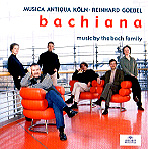Here’s another one of those Bach family samplers that, while not revealing any more than we already know regarding the towering superiority of Johann Sebastian, does bring to light works that were only “recently discovered”. All were written by relatives older than Sebastian, and among these the most interesting are the Overture (Suite) in G and Concerto in D by Johann Ludwig (1677-1731). The former, for strings, a pair of oboes, and continuo, begins boldly in the most formal French manner, then springs into a lilting, tuneful Air, followed by a bouncy Menuet, appropriately lively yet sturdy Gavotte, a second Air even more playful (and Handelian) than the first, and concluding with an infectious Bourrée. Ludwig’s Concerto shows an affinity for oboe writing in the Adagio and a grasp of energetic dance-rhythm in the final Allegro that in a world without the younger Sebastian certainly would have made a grander impression. But the decidedly artful work of the older Ludwig ultimately compels us to appreciate even more what the genius Sebastian could do with virtually the same materials. We’re given that chance at the end of the disc, where Reinhard Goebel and his excellent period-instrument Musica Antiqua Köln offer the fulfillment of an intriguing and oft-discussed notion: that the opening two-movement Sinfonia of Bach’s Easter Oratorio forms two-thirds of a three-movement concerto–completed by the oratorio’s opening chorus, which these performers happily (and successfully) add in a version “reconstructed” for instruments alone.
Of course, just because your name is Bach and you happen to be a musician doesn’t guarantee your ability to write memorable music–or even music worthy of any special attention. That’s proven by the two rather square, harmonically predictable, rhythmically staid sonatas “for five instruments” by Heinrich Bach (1615-92), the formulaic “battle” piece by Cyriacus Wilche (d. 1667)–Anna Magdalena’s grandfather and thus quite a stretch for inclusion here, and an interminable if inoffensive theme and 15 variations for harpsichord by Johann Christoph (1642-1703). Nevertheless, this is music well worth investigation by anyone who wants to explore a little more deeply the roots of the Bach family tree. The first-rate performances are accompanied by sound that’s on the dry side, giving extra bite and a slight rawness to the timbres that works very well for this unusual if not essential repertoire.
































